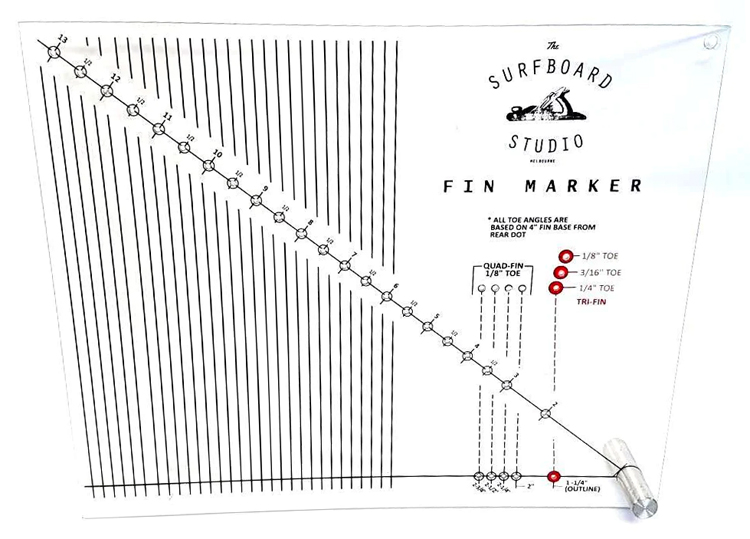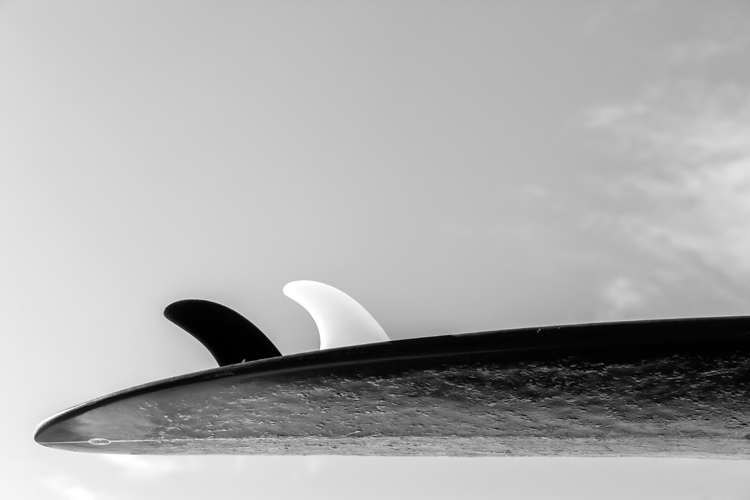Symmetry and balanced hydrodynamics performance are a surfboard shaper's ultimate goal, where fins play a critical role.
The surfboard fin marker is a relatively new shaping room tool that board builders increasingly use to mark where fin boxes should be installed.
It is a three-millimeter pulley card with an aluminum threaded rod on the corner featuring multiple markings and small holes.
For years, surfboard constructors used the shaper's layout square, a transparent sheet that sits flat on the blank and provides multiple measurements from stringer to rail.
Many old-school shapers, for instance, still use square rulers and the G-square measuring tool to perform these calculations.
The new tool takes the measurements from the rail, making the fin box placement annotation work easier and more accurate.
Designed in San Clemente
The surfboard fin marker was developed by San Clemente duo Terry Senate and Timmy Patterson to overcome managing multiple board shapes, fin setups and systems, and routing templates.
The surfboard builders wanted to create a simple tool that allowed the marking of the dots without any measurements except the distance from the tail along the stringer.
The fin marker also enables craftspeople to check fin box placements and toe-in angles on any surfboard or to confirm previous markings before routing.
Because boards are not 100 percent symmetric in relation to the stringer, this plastic sheet tool featuring marking holes for pencils or fine point pens takes the rail as the measuring starting point.
Unlike traditional layout squares, this simple tool solves the problem of deviations caused by off-centered stringers, meaning that fins will always be perfectly positioned, and no line needs to be drawn.

A Tool for All Boards and Fins
The surfboard fin marker allows board builders to note down the position of the fin boxes for all types of fin setups: single fin, twin fin, thruster, quad fin, or five fins.
While marking the fin box position, it's important to consider two critical variables:
- Distance From the Tail: If the fins are placed too far back, the board will feel stiff but will provide a lot of drive. If the fins are further forward, the board will turn and pivot easier but will have less drive. As a general rule of thumb, they're normally positioned 11''-12'' up from the tail, where most back feet land. The average marking off the rail for thrusters is 1-1/8'' or 1-1/4'' and 2 to 2-3/4'' for quads;
- The Toe-In: The toe-in is the fin angle to the stringer. The more the fins are parallel to the string, the faster the board will be, and the harder it will be to turn it. The more you toe them toward the nose, the more control you have and the looser the board will feel, but simultaneously, drag will increase, and it will be slower. The standard fin toe-in measurements are 1/4'' for the front fins in a thruster or quad setup and 1/8''- 3/16'' for rear quads fins, keels, and twin fins;
Here's an example of how to use the surfboard fin marker on a five-fin configuration:
- Run the tool's diagonal line along the stringer and use a pencil to mark where your fins will be in relation to the surfboard tail - more up or down;
- Align the tool's baseline with the dot you measured for your side quad fins;
- Double-check and align the tool's vertical line with the stringer;
- Mark the trailing and leading edge of the quad fin with the 1/8'' toe in;
- Move the tool up and mark the two dots for the thruster fins with one of the three optional toe-in angles: 1/8'', 3/16'', or 1/4'';
- Flip the fin marker and do the same marks on the other side;
